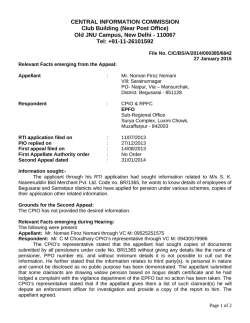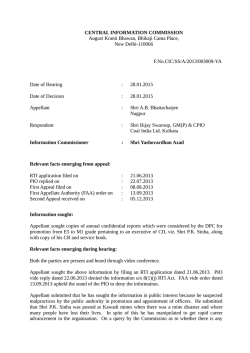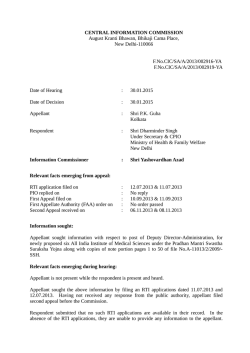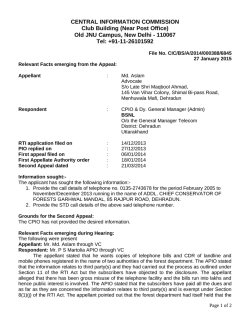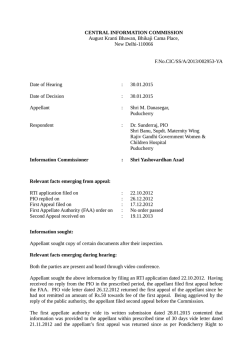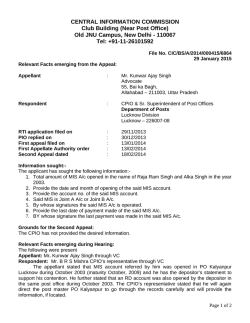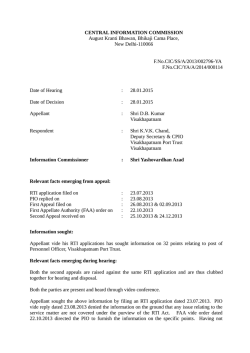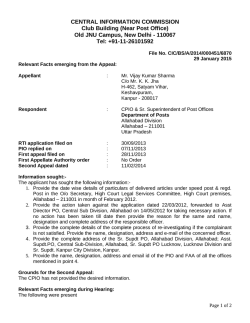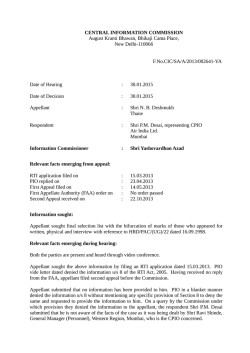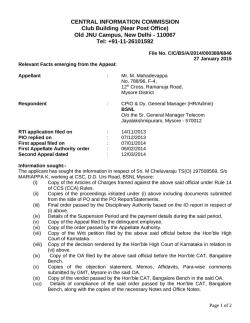
see superior court iop 65.37 cigna corporation, in the
J-A25031-14 NON-PRECEDENTIAL DECISION - SEE SUPERIOR COURT I.O.P. 65.37 CIGNA CORPORATION, IN THE SUPERIOR COURT OF PENNSYLVANIA Appellant v. EXECUTIVE RISK INDEMNITY, INC. AND NUTMEG INSURANCE COMPANY, Appellees No. 3538 EDA 2013 Appeal from the Order October 21, 2013 in the Court of Common Pleas of Philadelphia County Civil Division at No.: February, Term, 2012 No. 003993 BEFORE: DONOHUE, J., WECHT, J., and PLATT, J.* MEMORANDUM BY PLATT, J.: Appellant, Cigna Corporation, FILED FEBRUARY 03, 2015 appeals from the order granting summary judgment in favor of Appellees, Executive Risk Indemnity, Inc. and Nutmeg Insurance Company, and dismissing Appellant’s complaint with prejudice.1 Appellant sought a declaration of coverage under a fiduciary liability policy for ERISA2 violations found in an underlying federal class action. Appellees denied coverage under a policy exclusion for deliberately ____________________________________________ * Retired Senior Judge assigned to the Superior Court. 1 Although the order appealed from is dated October 18, it was docketed on October 21. We have amended the caption accordingly. 2 Employee Retirement Income Security Act of 1974, 29 U.S.C. §§ 1001– 1461. J-A25031-14 fraudulent or criminal acts or omissions. Appellant challenges the trial court’s application of the fraudulent acts exclusion. We affirm. The material facts of the underlying litigation are not in substantial dispute, although the parties disagree markedly on the legal consequences. (See Appellant’s Brief, at 5-18; Appellees’ Brief, at 4-14). However, this protracted course of litigation has extended longer than a decade. We summarize only the facts most relevant to this appeal.3 On December 21, 1998 Cigna amended its retirement plan, retroactive to January 1, 1998. In simplified terms, Cigna converted its traditional defined benefit pension plan to a cash balance plan. Cigna assured plan participants in the notification materials that the conversion would not affect benefits accrued as of December 31, 1997. presented as an enhanced benefit. In fact, the conversion was Nevertheless, there is no dispute on appeal that under certain circumstances some plan participants would have their expected benefits or accruals reduced or frozen, in a process designated “wear away.”4 Furthermore, there is no dispute that to avoid an ____________________________________________ 3 A more complete factual account is contained in Amara v. CIGNA Corp., 534 F.Supp.2d 288 (D. Conn. 2008), and Amara v. CIGNA Corp., 559 F.Supp.2d 192 (D. Conn. 2008), as well as the Supreme Court’s discussion of the case in CIGNA Corp. v. Amara, 131 S. Ct. 1866 (2011). To avoid confusion, and aid in clarification, rather than employ sequential numerals, we will continue to provide citations for the various stages of the Amara litigation, unless the specific case cited is otherwise clear in context. 4 “Wear away occurs when an employee continues to work at a company but does not receive additional benefits for those additional years of service.” (Footnote Continued Next Page) -2- J-A25031-14 anticipated employee backlash at the wear away phenomenon (and the possible reduction in retirement benefits), Appellant withheld or declined to provide documentation which would have confirmed the risk of reduced benefits. In 2001, plan participants brought a class action lawsuit on behalf of some 27,000 employees, alleging in essence that the plan amendments had the net effect of reducing benefits or benefit accruals for some plan participants in violation of ERISA. Eventually, Judge Mark R. Kravitz, of the federal district court in Connecticut, decided that Appellant’s changes were permitted under ERISA, but that Appellant or its affiliate pension plan had violated ERISA-required notice provisions by providing misleading summary plan descriptions (SPD’s) and Summaries of Material Modifications (SMM’s) (Footnote Continued) _______________________ Amara v. CIGNA Corp. 2014 WL 7272283, *4 (C.A.2 (Conn. (C.A.2 (Conn.), filed December 23, 2014). Wear away means that there are periods of time in which the employee’s account balance is less than the employee's minimum benefit. What wear away means in practice is that even though an employee is continuing each year to receive pay and interest credits under Part B, and the employee's account balance may even be growing, it nonetheless remains less than the minimum benefit earned as of December 31, 1997; in effect, where there is wear away, even though the employee continues to work for CIGNA and continues to receive benefit credits, the employee’s expected retirement benefits have not grown beyond what the employee was entitled to under Part A as of December 31, 1997. Amara v. Cigna Corp., 534 F.Supp.2d 288, 303-04 (D. Conn. 2008). -3- J-A25031-14 in an apparent effort to forestall objections from plan participants. See Amara v. Cigna Corp., 534 F.Supp.2d 288, 296 (D. Conn. 2008) (referred to by the parties as Amara I).5 In pertinent part, the district court summarized its findings of fact and conclusions of law as follows: [I]n effectuating the conversion to the cash balance plan, CIGNA did not give a key notice to employees that is required by ERISA; and CIGNA’s summary plan descriptions and other materials were inadequate under ERISA and in some instances, downright misleading. ERISA gives employers substantial leeway in designing a pension plan, and the Court believes that CIGNA’s Plan complies with the relevant statutory provisions. However, ERISA also emphasizes the importance of disclosure by employers to employees regarding the details of the company’s pension plan, to enable employees to plan for their retirement and to make decisions of profound importance for their lives. This is where CIGNA failed to fulfill its obligations; the company did not provide its employees with the information they needed to understand the conversion from a traditional defined benefit plan to a cash balance plan and its effect on their retirement benefits. Id. (emphasis added). In a subsequent opinion, Judge Kravitz ordered the reformation of the contract (the pension plan) as a remedy for Appellant’s violations. See Amara v. CIGNA Corp., 559 F.Supp.2d 192, 222 (D. Conn. 2008). The parties cross-appealed. opinion. The Second Circuit affirmed in an unpublished See Amara v. CIGNA Corp., 348 Fed. Appx. 627, 2009 WL 3199061 (C.A.2 (Conn.) 2009). ____________________________________________ 5 This decision is also variously referred to by the parties and the trial court as the “Liability Opinion.” -4- J-A25031-14 However, the United States Supreme Court vacated and remanded. See CIGNA Corp. v. Amara, 131 S. Ct. 1866 (U.S. 2011). In reviewing whether the district court applied the correct legal standard for relief, the High Court reasoned, in part, that the district court relied on the wrong ERISA remedy provision. See id. at 1871. On remand, because Judge Kravitz had died in the meantime, the case was reassigned to District Court Judge Janet Bond Arterton. Judge Arterton decided in pertinent part that the remedy of contract reformation was appropriate. Specifically, she decided that: CIGNA engaged in fraud or similarly inequitable conduct. See 3 John N. Pomeroy, A Treatise on Equity Jurisprudence § 873 at 421 (5th ed. 1941) (stating that while “fraud” has no precise definition in equity, it generally consisted of “obtaining an undue advantage by means of some intentional act or omission that was unconscientious or a violation of good faith”); see also Tokio Marine & Fire Ins. Co. v. Nat'l Union Fire Ins. Co., 91 F.2d 964, 966 (2d Cir. 1937) (reformation was appropriate based on one party’s unilateral mistake combined with the fact that the court could infer that the other party knew of the mistake, knowledge which alone qualified as the “inequitable conduct” necessary to reform the contract). CIGNA’s deficient notice led to its employees' misunderstanding of the content of the contract, and CIGNA did not take steps to correct their mistake. Instead, CIGNA affirmatively misled and prevented employees from obtaining information that would have aided them in evaluating the distinctions between the old and new plans. See Amara I, 534 F.Supp.2d at 343 (finding that CIGNA informed its benefits department and consulting company not to provide benefits comparisons under the old and new plans). Furthermore, CIGNA sought and obtained an advantage from its inequitable actions. See id. (finding that CIGNA intentionally and successfully avoided adverse employee reactions, which had caused other employers to modify their intended cash balance plans). -5- J-A25031-14 As a result of CIGNA’s fraud, its employees were mistaken as to their retirement benefits. Amara v. CIGNA Corp., 925 F.Supp.2d 242, 253 (D. Conn. 2012) (one citation omitted; emphasis in original). The Second Circuit affirmed. See Amara v. CIGNA Corp., 2014 WL 7272283 (C.A.2 (Conn.) filed December 23, 2014). In specifically addressing the issue of fraud, the Second Circuit explained: (a) Fraud While no “single statement . . . accurately define[s] the equitable conception of fraud,” it generally consists of “obtaining an undue advantage by means of some act or omission which is unconscientious or a violation of good faith.” 3 John N. Pomeroy, A TREATISE ON EQUITY JURISPRUDENCE § 873 at 420– 21 (5th ed. 1941). Here, defendants misrepresented the terms of CIGNA’s new pension plan and actively prevented employees from learning the truth about the plan. As Judge Kravitz put it in Amara I, “CIGNA employees suffered from the lack of accurate information in CIGNA’s disclosures, and CIGNA was aware of this fact.” Amara I, 534 F.Supp.2d at 342; see also id. at 349 (deciding that CIGNA made “materially misleading statements” about wear away). CIGNA’s misbehavior was designed to “ease the transition to a less favorable retirement program.” Id. at 343. As a result, the district court did not err in finding that defendants obtained undue advantage through these actions by avoiding adverse employee reactions. See Amara IV, 925 F.Supp.2d at 253 (ruling that “CIGNA engaged in fraud or similarly inequitable conduct”). Id. at *13. During the relevant time period, Appellant was insured under a multiline insurance policy, including professional liability and fiduciary liability. The primary insurer was Certain Underwriters of Lloyd’s of London. Appellees were excess carriers whose obligations were determined on a -6- J-A25031-14 follow-form basis to the Lloyd’s of London policy (i.e., tracking the terms, conditions, and exclusions of the primary Lloyd’s policy).6 In 2012, Appellant filed the complaint at issue in this appeal, seeking, inter alia, a declaratory judgment to declare coverage under the fiduciary liability provisions of the policy for claims made against it in the underlying class action, Amara v. Cigna Corp., 534 F.Supp.2d 288 (D. Conn. 2008) (and its progeny). Appellees filed a motion for summary judgment. The trial court granted the motion for summary judgment, and dismissed Appellant’s complaint with prejudice in an order and opinion dated October 18, 2013, and docketed on October 21, 2013. Appellant filed a motion for reconsideration, which the trial court denied.7 This timely appeal followed.8 Appellant raises two questions for our review on appeal: 1. Did the trial court commit an error of law or abuse of discretion in applying the “deliberately fraudulent acts” exclusion to preclude coverage under the Fiduciary Liability coverage part? ____________________________________________ 6 Other excess carriers settled separately. (See Appellant’s Brief, at 16 n.7; see also Appellees’ Brief, at 14 n.3). 7 In any event, it would appear, as argued by Appellees, that Appellant’s motion for reconsideration was untimely. See Pa.R.C.P. No. 227.1(c) (“Post-trial motions shall be filed within ten days . . . .“); (see also Appellees’ Brief, at 14). 8 The trial court did not order a statement of errors. See Pa.R.A.P. 1925(b). The trial court filed an opinion on January 2, 2014, referencing and adopting its order and opinion of October 18, 2013, as its opinion on appeal. See Pa.R.A.P. 1925(a). -7- J-A25031-14 2. Did the trial court commit an error of law of abuse of discretion in finding that Amara v. CIGNA Corp. 925 F.Supp.2d 242 (D. Conn. 2012) . . . constitutes a “final judgment” sufficient to effectuate the application of the “deliberately fraudulent acts” exclusion? (Appellant’s Brief, at 4). Our review on an appeal from the grant of a motion for summary judgment is well-settled. A reviewing court may disturb the order of the trial court only where it is established that the court committed an error of law or abused its discretion. As with all questions of law, our review is plenary. In evaluating the trial court’s decision to enter summary judgment, we focus on the legal standard articulated in the summary judgment rule. Pa.R.C.P. 1035.2. The rule states that where there is no genuine issue of material fact and the moving party is entitled to relief as a matter of law, summary judgment may be entered. Where the non-moving party bears the burden of proof on an issue, he may not merely rely on his pleadings or answers in order to survive summary judgment. Failure of a non-moving party to adduce sufficient evidence on an issue essential to his case and on which it bears the burden of proof . . . establishes the entitlement of the moving party to judgment as a matter of law. Lastly, we will view the record in the light most favorable to the non-moving party, and all doubts as to the existence of a genuine issue of material fact must be resolved against the moving party. Murphy v. Duquesne University of the Holy Ghost, 777 A.2d 418, 429 (Pa. 2001) (citations and quotation marks omitted). Furthermore, [W]e apply the same standard as the trial court, reviewing all the evidence of record to determine whether there exists a genuine issue of material fact. . . . Only where there is no genuine issue as to any material fact and it is clear that the moving party is entitled to a judgment as a matter of law will summary judgment be entered. Motions for summary judgment necessarily and directly implicate the plaintiff’s proof of the elements of [his] cause of action. Summary judgment is proper if, after the completion of -8- J-A25031-14 discovery relevant to the motion, including the production of expert reports, an adverse party who will bear the burden of proof at trial has failed to produce evidence of facts essential to the cause of action or defense which in a jury trial would require the issues to be submitted to a jury. Pa.R.C.P. 1035.2. Thus, a record that supports summary judgment will either (1) show the material facts are undisputed or (2) contain insufficient evidence of facts to make out a prima facie cause of action or defense and, therefore, there is no issue to be submitted to the jury. Upon appellate review, we are not bound by the trial court’s conclusions of law, but may reach our own conclusions. The appellate Court may disturb the trial court’s order only upon an error of law or an abuse of discretion. Judicial discretion requires action in conformity with law on facts and circumstances before the trial court after hearing and consideration. Consequently, the court abuses its discretion if, in resolving the issue for decision, it misapplies the law or exercises its discretion in a manner lacking reason. Similarly, the trial court abuses its discretion if it does not follow legal procedure. Where the discretion exercised by the trial court is challenged on appeal, the party bringing the challenge bears a heavy burden. [I]t is not sufficient to persuade the appellate court that it might have reached a different conclusion if . . . charged with the duty imposed on the court below; it is necessary to go further and show an abuse of the discretionary power. An abuse of discretion is not merely an error of judgment, but if in reaching a conclusion the law is overridden or misapplied, or the judgment exercised is manifestly unreasonable, or the result of partiality, prejudice, bias or ill will, as shown by the evidence or the record, discretion is abused. Nat’l Cas. Co. v. Kinney, 90 A.3d 747, 752-53 (Pa. Super. 2014) (case citations and quotation marks omitted). The interpretation of an insurance policy is a question of law that we review de novo. -9- J-A25031-14 Our purpose in interpreting insurance contracts is to ascertain the intent of the parties as manifested by the terms used in the written insurance policy. When the language is clear and unambiguous, we must give effect to that language. However, when a provision in the policy is ambiguous, the policy is to be construed in favor of the insured to further the contract’s prime purpose of indemnification and against the insurer, as the insurer drafts the policy and controls coverage. Lexington Ins. Co. v. Charter Oak Fire Ins. Co., 81 A.3d 903, 908 (Pa. Super. 2013) (citations omitted). Whether [the insurer] breached a duty imposed by contract is a legal conclusion. Mellon Bank, N.A. v. Nat'l Union Ins. Co. of Pittsburgh, PA, 768 A.2d 865, 869 (Pa. Super. 2001) (“A legal conclusion is a statement of a legal duty without stating the facts from which the duty arises. A statement of the existence of a fact could be a legal conclusion if the fact stated is one of the ultimate issues in the proceeding.”). We must, therefore, examine the factual averments to determine whether they support the conclusion. Joyce v. Erie Ins. Exchange, 74 A.3d 157, 168 (Pa. Super. 2013). Commonwealth v. Hawkins, 294 Pa. Super. 57, 439 A.2d 748, 751 (1982); and Commonwealth v. Eackles, 286 Pa. Super. 146, 428 A.2d 614, 618 (1981), which both define fraud as being “a false representation of a material matter made with knowledge of its falsity and with the intent to deceive.” Id. This definition does not include the element of detriment. In Hawkins, the underlying crime was theft by unlawful taking and because there was no requirement to prove a false representation to convict on that charge, the fraud extension did not apply. In Eackles, the underlying crime was receiving stolen property. Again, there was no requirement to prove a false representation to prove the crime, so the exception was irrelevant. However, here, the crime specifically includes making a false representation. For purposes of this appeal, [the appellant] admits there was a false statement knowingly made with the intent to deceive. Therefore the definition of fraud as relied upon in Hawkins and Eackles has been established. - 10 - J-A25031-14 Commonwealth v. Riding, 68 A.3d 990, 996-97 (Pa. Super. 2013) (footnote omitted). In this Commonwealth the rule is so firmly established that the Superior Court has said it is irrelevant whether or not [the insured] intended to be bound by the [policy’s] exclusion for intentional torts, since it is against the public policy of this Commonwealth to provide insurance coverage for intentional acts. State Farm Mut. Auto. Ins. Co. v. Martin, 660 A.2d 66, 67-68 (Pa. Super. 1995), appeal denied, 678 A.2d 366 (Pa. 1996) (citation and quotation marks omitted) (emphasis added). Here, preliminarily, we note that Appellant fails to divide its argument “into as many parts as there are questions to be argued; and shall have at the head of each part─in distinctive type or in type distinctively displayed─the particular point treated therein, followed by such discussion and citation of authorities as are deemed pertinent.” Pa.R.A.P. 2119(a); (see also Appellant’s Brief, at 21-40).9 In general support of its first claim, Appellant argues that it has coverage under the policy provision for wrongful acts. (See Appellant’s Brief, at 15, 26). Notably, Appellant does not dispute that “the Liability Opinion,” Amara, supra (534 F.Supp.2d 288), found that its (Cigna’s) summary plan ____________________________________________ 9 We could find both of Appellant’s claims waived on this basis alone, but we will review them on the merits in the interest of juridical economy. - 11 - J-A25031-14 descriptions and summary of material modifications were “affirmatively and materially misleading.” (Appellant’s Brief, at 29).10 Nevertheless, Appellant maintains that the fraudulent acts exclusion does not apply. Appellant posits that the policy covers its conduct as a “Wrongful Act,” defined in the policy to include “‘any actual or alleged . . . misstatement, misleading statement, act, omission’ [sic] on the part of the insured.” (Appellant’s Brief, at 26). We disagree. We begin by observing that “[u]nder Pennsylvania law . . . the court’s duty is to ascertain the intent of the parties as manifested in the language of the written instrument. In discharging this duty, the court must view the policy in its entirety, giving effect to all of its provisions. Cont’l Cas. Co. v. Pro Machine, 916 A.2d 1111, 1121 (Pa. Super. 2007) (internal quotation marks and citation omitted) (emphasis added). “Also, the words of the insurance policy must be construed in their natural, plain, and ordinary sense. Moreover, an insurance policy, like every other written contract, must be read in its entirety and the intent of the policy is gathered from consideration of the entire instrument.” Ins. Co. of Evanston v. Bowers, ____________________________________________ 10 Specifically, the court found that “CIGNA sought to negate the risk of backlash by producing affirmatively and materially misleading notices regarding Part B. As a result, its § 204(h) notice failed to meet ERISA’s stringent standards.” Amara v. Cigna Corp., 534 F.Supp.2d 288, 344 (D. Conn. 2008). - 12 - J-A25031-14 758 A.2d 213, 216 (Pa. Super. 2000) (internal quotation marks and citation omitted). Appellant’s argument, in effect, would have us (and the trial court) read the wrongful acts provision as negating the fraudulent acts exclusion. (See Appellant’s Brief, at 25) (“Further, there is no exclusion for deliberately or intentionally misleading statements, acts, or omissions.”). We disagree. To the contrary, the plain meaning of the policy is that the fraudulent or criminal act exclusion operates as an exception to the more general wrongful acts coverage provision. We read the insurance policy in its entirety, not piecemeal, “giving effect to all of its provisions.” Pro Machine, supra at 1121. We further note that both the federal district court, and the Second Circuit in affirmance, expressly concluded that Appellant’s conduct was fraudulent. See Amara v. CIGNA Corp., 925 F.Supp.2d at 253 (“CIGNA engaged in fraud or similarly inequitable conduct.”); see also Amara, WL 7272283 at *13, affirming. In affirming, the Second Circuit concluded, “Based on our review of the record as a whole, we conclude that the district court did not err—much less clearly err—in determining that the plaintiffs established “a basis for [the court] to reform the CIGNA Pension Plan due to CIGNA’s fraud paired with Plaintiffs’ unilateral mistake.” (emphasis added). - 13 - Id. at *12-13 J-A25031-14 In addition to an unequivocal finding of fraud in the Amara litigation, we observe that Appellant’s conduct, including affirmative efforts at concealment and intentionally misleading representations that the benefits under the previous plan would not be disturbed, would clearly qualify as fraudulent under Pennsylvania law. See Commonwealth v. Riding, 68 A.3d 990, 996-97 (Pa. Super. 2013) (“a false representation of a material matter made with knowledge of its falsity and with the intent to deceive.”) (citing Commonwealth v. Hawkins, 439 A.2d 748, 751 (Pa. Super. 1982); and Commonwealth v. Eackles, 428 A.2d 614, 618 (Pa. Super. 1981). We also reject Appellant’s suggestion that the Amara trial court’s finding of fraud on remand was mere dictum. (Appellant’s Brief, at 39). “Black’s Law Dictionary defines obiter dictum as [a] judicial comment made during the course of delivering a judicial opinion, but one that is unnecessary to the decision in the case and therefore not precedential (though it may be considered persuasive). Black’s Law Dictionary 1100 (7th ed. 1999).” C.B. v. J.B., 65 A.3d 946, 959 (Pa. Super. 2013), appeal denied, 70 A.3d 808 (Pa. 2013) (internal quotation marks omitted). Here, the Amara trial court’s determination of fraud was integral, if not critical, to its finding of the appropriateness of the remedy, as well as to the Second Circuit’s reasoning in affirmance. Appellant’s first claim does not merit relief. - 14 - J-A25031-14 In its second question, Appellant posits that the trial court erred or abused its discretion because the federal court’s finding of fraud was not a final judgment. (See Appellant’s Brief, at 4). We disagree. In addition to Appellant’s argument that the finding of fraud by Judge Arterton was mere dictum, which we categorically reject, it appears to argue further that because the federal courts occasionally referred to fraud in conjunction with “other inequitable conduct,” in part by reference to a learned treatise, that “the court did not reach a final judgment that Cigna’s conduct was fraudulent.” (Appellant’s Brief, at 39). We emphatically disagree. “[N]o ‘single statement . . . accurately define[s] the equitable conception of fraud[.]’” Amara v. CIGNA Corp. 2014 WL 7272283, *13 (C.A.2 (Conn.) filed December 23, 2014). Here, we conclude for purposes of our review that the federal courts were entitled to discuss fraud in the context of prior authority, and their adoptive use of alternative formulations does not detract from their unequivocal finding of fraud. Appellant offers no controlling authority in support of its argument for a legal distinction. (See Appellant’s Brief, at 30, 39). The claim has no merit. Finally, on the issue of finality, we note that under Pennsylvania law, the federal courts’ finding of fraud would clearly constitute a final judgment. “[W]hat effect a civil appeal has on an otherwise final judgment has been answered. A judgment is deemed final for purposes of res judicata or - 15 - J-A25031-14 collateral estoppel unless or until it is reversed on appeal.” Shaffer v. Smith, 673 A.2d 872, 874-75 (Pa. 1996) (citations omitted).11 Appellant’s second claim is without merit. Order affirmed. Judgment Entered. Joseph D. Seletyn, Esq. Prothonotary Date: 2/3/2015 ____________________________________________ 11 Moreover, we reject Appellant’s assertion that coverage of intentional acts would not be precluded by public policy in Pennsylvania. (See Appellant’s Brief, at 37). Pennsylvania caselaw is unequivocal that reimbursement from insurance for intentional acts is against the public policy of the Commonwealth. See Blackman v. Wright, 716 A.2d 648, 650 (Pa. Super. 1998), appeal withdrawn, 727 A.2d 1115 (Pa. 1998) (“in the context of contracts for insurance, it is against the public policy of this Commonwealth to provide insurance coverage for intentional acts”) (quoting State Farm v. Martin, supra at 68). Appellant attempts to distinguish numerous cases reflecting this policy, and draws a universal conclusion that “there is no blanket public policy in Pennsylvania against insurance coverage for intentional acts.” (Appellant’s Brief, at 37; see also id. at 32-38). We are unpersuaded. While many of these cases, and cases holding similarly, arose in the context of deliberate motor vehicle collisions, or assaults, and the like, our caselaw does not limit the policy preclusion to these types of cases. We perceive no reason or basis to read an exception into the public policy under the facts of this case. - 16 -
© Copyright 2026
